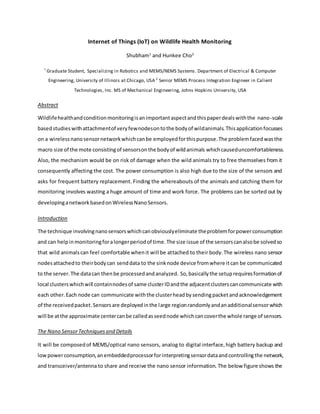
Peer Graded Mini Project- Nanosensors_rev3
- 1. Internet of Things (IoT) on Wildlife Health Monitoring Shubham1 and Hunkee Cho2 1 Graduate Student, Specializing in Robotics and MEMS/NEMS Systems. Department of Electrical & Computer Engineering, University of Illinois at Chicago, USA 2 Senior MEMS Process Integration Engineer in Calient Technologies, Inc. MS of Mechanical Engineering, Johns Hopkins University, USA Abstract Wildlifehealthandconditionmonitoringisanimportantaspectandthispaperdealswiththe nano-scale basedstudieswithattachmentof veryfewnodesontothe bodyof wildanimals.Thisapplicationfocusses on a wirelessnanosensornetworkwhichcanbe employedforthispurpose.The problemfacedwasthe macro size of the mote consistingof sensorsonthe bodyof wildanimals whichcauseduncomfortableness. Also, the mechanism would be on risk of damage when the wild animals try to free themselves from it consequently affecting the cost. The power consumption is also high due to the size of the sensors and asks for frequent battery replacement. Finding the whereabouts of the animals and catching them for monitoring involves wasting a huge amount of time and work force. The problems can be sorted out by developinganetworkbasedonWirelessNanoSensors. Introduction The technique involvingnanosensorswhichcanobviouslyeliminate theproblemforpowerconsumption and can helpinmonitoringforalongerperiodof time.The size issue of the sensorscanalsobe solvedso that wild animalscan feel comfortable whenit will be attached to their body.The wireless nano sensor nodesattachedto theirbodycan senddata to the sinknode device fromwhere itcan be communicated to the server.The datacan thenbe processedandanalyzed. So,basicallythe setuprequiresformationof local clusterswhichwill containnodesof same clusterIDandthe adjacentclusterscancommunicate with each other.Each node can communicate withthe clusterheadbysendingpacketandacknowledgement of the receivedpacket.Sensorsare deployedinthe large regionrandomlyandanadditionalsensorwhich will be atthe approximate centercanbe calledasseednode whichcancoverthe whole range of sensors. The Nano SensorTechniquesand Details It will be composedof MEMS/optical nano sensors, analog to digital interface,high battery backup and lowpowerconsumption,anembeddedprocessorforinterpretingsensordataandcontrollingthe network, and transceiver/antenna to share and receive the nano sensor information. The below figure shows the
- 2. optical imagesobtainedwitharraysof electrodeswithe-beamorientedelectrolyte channel.Itisbasically the formation of sink node. The potential of the cathode increase gradually at the potential level of led (Pd) wire which grows from cathode to anode. The electro- deposition of ledis performed here at very lowappliedcurrentinnA.The growthof wire canbe around7um.The electricalresistancealsodecreases as the ledwire reducesthe gapbetweencathodeandanode.The lithographicprocesscanbe thenapplied to create a patterned nano-structure of materials like silicon. This technique uniquely highlights the potential forthisnanosensingprocessthroughnano-electronics,sensingandelectromechanical systems. Figure 1. The solid structure of Nano Sensor The processthenfollowedbythe sinknode clusterleaderisestablishingthe pathwiththe non-sinknode leadersso that packetscontaininginformationcanbe shared and broadcasted.Initiallythe hop counter is set to zero to the packet to be transferred. On receiving the packet, each node increments the hop counter by one and compares it to its own counter. If it is larger than hop counter in the packet, it has foundashorterpathto sinknode.If thenupdatesitscounterandsetsthe nexthoppointertothe neighbor from which the packet as sent. This completes the setup with every node in the network has path gradientstowardssinknode. Figure 2. Deployment of Protocol
- 3. A flexible and tattoo stylesensorstructure This sensor below was developed for a premature baby’s brain waves but it will be able to apply to this fielddue toflexibleandintegratedcharacteristics.Animalsneverindicatethiskindof sensoranditwould be useful to collect information from animals’ skin. It picks up electric signals in the skin and transmits themwirelesslytodevices.Thissensorhasawirelessantennafordatatransmission,awirelesspowercoil onto the device, LED and light sensing devices to collect a variety of electrical signals on the surface of animalslike bloodoxygenation,temperature,mechanical strainsof skin. Figure 3. Flexible and wearable Nano Sensor Implementation of Data Mining into Wildlife Monitoring The sensordevice placedonthe bodyof the animal sendthe data of theirphysical characteristicstothe Forest server from where the data can be taken for further mining. The data mining technique will help to findoutthe relationshipamongthe parametersof activitiesof wildanimalsduringdifferentsituations like hunting, sleeping, wounded etc. For an example, the frequency of hunting can be detected by the dataobtainedfrombodytemperature.The woundsonthe legcan be identifiedbythe walkingspeeddata takenthroughinertiasensorattachedtothe legs. Conclusions&FurtherResearch The detection systems asks for more flexibility in variety of wireless networks and devices that can be easilyadapted.Alsoasapartof furtherresearchwe canhave sensorswhichcanevencarrydrugsthatcan instantly be injected to the animals in case the wild animals are suffering from heavy pain, high or low bloodpressure issue,highbodytemperature etc.andforestofficialsare locatedat far distance to reach immediatelyatthe site.Butthatasksfor more complex mechanismfordataminingandimplantingmore bulky sensors on the body of animals. Immediate curing action has to be triggered by the operator to make the drug delivering sensor work instantly. So it creates a kind of dependence on the operator. However,possibilitiesof makingthissuccesscan’tbe deniedirrelevantof the complexityinvolvedseeing
- 4. the nano sensors service in the IoT. In addition, sensors that can harvest a power from a bio energy or powerscavengingfromvibrationbyanimal movementwouldminimizethe powerlossof sensors. References [1] BartoszWietrzyk,MilenaRadenkovic,"RealisticLarge Scale adhoc Animal Monitoring",School of ComputerScience,Universityof Nottingham. [2] ShahSheetal,"AutonomicWirelessSensorNetworks",Viterbi School of Engineering,Universityof SouthernCalifornia,LosAngeles,CA,USA. [3] Dr MilenaRadenkovicandProf.ChrisGreenhalgh,"Applicationof Mobile Ad-HocNetworksto Monitoringof Farm Animals",Technical Overview. [4] http://howellfoundation.blogspot.com/2015/01/on-science-and-tattoos-one-that-you.html [5] http://www.slideshare.net/VRyzhonkov/body-sensor-networks-challenges-applications-37117319